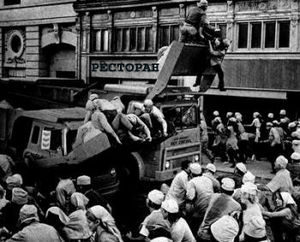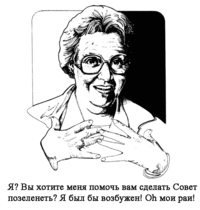Soviet Green
“In Soviet Russia, people is Soviet Green!”
– Russian Reversal on Soviet Green
“We liked Germany's idea of making sausage out of them, but we didn't want anything shaped like that in our mouths... especially something already as gay as the French. So we made them square.”
– Baracksky Obamanov on the shape of Soviet Green
Soviet Green is a food-like substance primarily enjoyed by the people of Russia. It is composed of freeze-dried, high-density fiberboard and spiced meat, and is dark green in color. Its exact recipe is a secret, although it has been rumored to contain whale bone, elephant penis, walrus whiskers, seal tongue, and expired Twinkies®.
History[edit | edit source]
Soviet Green was a invented in the mid 19th century as a means of dispensing rations to the poor, failing Soviet community. Shortly after Napoleon Bleaunaparté chased the Russian Army into Siberia (a now-infamous failed war tactic known by historians as "Napoleon's Dumbass Stand") the Russian Army, warm and cozy in their Soviet hats, turned back towards enemy lines to discover that the French had become frozen solid. Short on food and supplies, the they were forced to eat Napoleon's men, which they dubbed "Frenchsicles."
The Army would dig long ditches up to a kilometer (about ⅝ of one mile) long and fill them with vodka; the Frenchmen would then be rolled into the ditches and left to thaw. The vodka-soaked corpses would be set ablaze and roasted for approximately one hour. Finally, the meat would be packed into sandwich boxes and refrozen in the Siberian icepack. This ensured that any uncooked drippings would remain solid and could easily be stored for later use.
After gorging themselves on cannibal croissants and people parfait, the Russian Army discovered that they liked the French after all (dipped in mayo and topped with Soviet Onion) and packed up what was left of the meat into their olive-drab green packs. Upon returning to the Motherland, the new cuisine was sampled by their komrades. Frenchsicles became a staple in Russia, so much so that that the socialist government which rightfully owned the feast needed to ration it out equally among the people.
Early Production and Distribution[edit | edit source]
During the War of the Sixth Coal Collecting Mission, the Russian Army had little to do with their time besides tag along with the Continental Powers and collect the bodies of slain Frenchies. The Czar of Russia at the time, Baracksky Obamanov, had requested that the army return with Napolean's head on a fork. However, due to Napolean's lackluster size (about 3'6", or 107cm in height) the army instead handed him over to the British, along with mellon baller and a recipe for Soviet Green. The British, unable to read the recipe, burned it to heat water and used the mellon baller to steep their tea. Naturally, Napoleon escaped under British guard. In total, the Russian Army had acquired over 7,000 Frenchmen before returning to the Motherland.
The popularity of Soviet Green increased exponentially as the government began mass-producing as much as 6 metric tons per week of the freeze-dried squares. The main production facility was built precariously close to the French Embassy, while distribution centers were built on top of landfills all across the Soviet Union. By 1869, over 600 distribution centers were reporting "greenlines" up to two kilometers long. At times, intersecting lines of people trying to cross each other would develop mobs of hungry komrades breaking out into riots. Police squads were called to take action and keep the lines moving; permanently stationed squads eventually unionized and formed what is know known as the KGB (Kremlin Greenline Beaters.)
By the turn of the 20th century, airplanes were employed to deliver the Soviet Green to the people by dropping them from the sky via parachute. In 1910, a very smart Russian named Alexey Pajitnov suggested dropping the food from the airplane. Oftentimes the parachute would fail, due to the density of the payload, and freefalling Soviet Green would crash through the roof of hungry Russians. A hole in the roof was a small price to pay for one 5×5×1cm square, so long as the "зеленый хлеб от рая" (green bread from heaven) did not strike one in the head, which often lead to death and/or massive blood stains. Ironically, Alexey Pajitnov was injured in this manner, leading to the creation of MonoTяis, which eventually evolved into Teтяis.
Soviet Green as Currency[edit | edit source]
During the 1920s, Soviet Russia had begun producing a high-grade variety of Soviet Green, labeled as MBK (Мясо высокого качества, or "high quality meat). This special grade of the rations was produced specifically for the Russian Army, and was distinguished from the standard product with a red, undyed star of frenchmeat pressed into the center of the squares. MBK found its way into the black market, and was trading for the equivalent of 255 rubels, or about $8.33 USD (about $104.25 by 2008 standards when adjusted for inflation) according to a 1923 ledger of one black market storefront which sold collectible urinal cakes. Experts believe that the price may have gone higher during 1923, but the 255-rubel mark was maxed out due to the technologically limited 8-bit slide rules of the era.
Soon, these special red and green squares began to replace rubles in underground stores. Realizing that the government was now handing out "free money," efforts were made to rid the country of the black market community entirely. Government officials began printing copies of Matthew Lesko's How To Get All The Soviet Green You Can Into Your Pockets For Free Free Free. The farcical book was actually an instruction manual on making gas chamber showers, which according to the book, would "wash your skin clean of the poverty that makes you invisible to Uncle Gorbi." The book sold for two hundred MBK, thus returning the red and green squares back to the government, while tens of thousands of Russian citizens perished.
MBK was fazed out of production in 1949, and the remaining product was sold through MikhDonald's chains around the vast country. The 26-year-old frenchmeat was boiled, mashed, and tossed into a stew listed on the Value Menu as "The Big Makh."
Soviet Green Day[edit | edit source]
Today, top-grade MBK is produced for only two months a year, in preparation for the upcoming holiday to commemorate the history of the once-loved pseudomeat. December 10th is set aside as Soviet Green Day, a 24-hour celebration which starts at Midnight and ends at 11:59pm with the stoning of Matthew Lesko in effigy. Other festivities include bobbing for Soviet Green, pin the star on Matthew Lesko's mother, and shoot the star, a carnival game where children attempt to shoot out the entire red star from mock squares of MBK with fully-automatic AK-47s (which are chained to the booth to prevent accidental genocide).
The Soviet Green produced for the festival no longer uses French as meat. The closest-tasting alternative is the discarded foreskin of a freshly circumcised Jewish wooly mammoth, which is native to Siberia. This product is not kosher.
Soviet Green Day also marks the Changing Of The Expiration Date, where Soviet Green exported to the United States gets a fresh year stamped onto the package. Although the meat is technically spoiled before it is even canned, experts suggest that the sweltering conditions aboard the oil tankers on which the meat is shipped may actually pasteurize the product before it reaches the west. Participants of Soviet Green Day festivals often re-enact this process by voluntarily locking themselves inside steel sweat-boxes, competing with one another chanting "Восточное мясо западное" (East Meat West) repeatedly until one passes out or dies.
Modern Production and Use[edit | edit source]
The United Nations has banned the use of the French as meat since 1999, and to this day very little Soviet Green is ever produced. The popularity of the cuisine dropped dramatically, since no substitute for the Frenchman has been found nearly as palatable. An undyed, non-freeze-dried version is currently being exported to the United States and is sold under the trademarks Spam®, Treet®, and Smeet® (available only in Springfield, California; Springfield, Colorado; both Springfields in Florida; Springfield, Georgia; Springfield, Illinois; Springfield, Indiana; Springfield, Kentucky; Springfield, Louisiana; Springfield, Maine; Springfield, Massachusetts; Springfield, Minnesota; Springfield, Missouri; Springfield, Nebraska; Springfield, New Hampshire; both Springfields in New Jersey, Springfield, New York; Springfield, Ohio; Springfield, Oregon; Springfield Township, Pennsylvania; Springfield, South Carolina; Springfield, South Dakota; Springfield, Tennessee; Springfield, Texas; Springfield, Vermont Springfield, Virginia; Springfield, West Virginia; and all five Springfields in Wisconsin).


